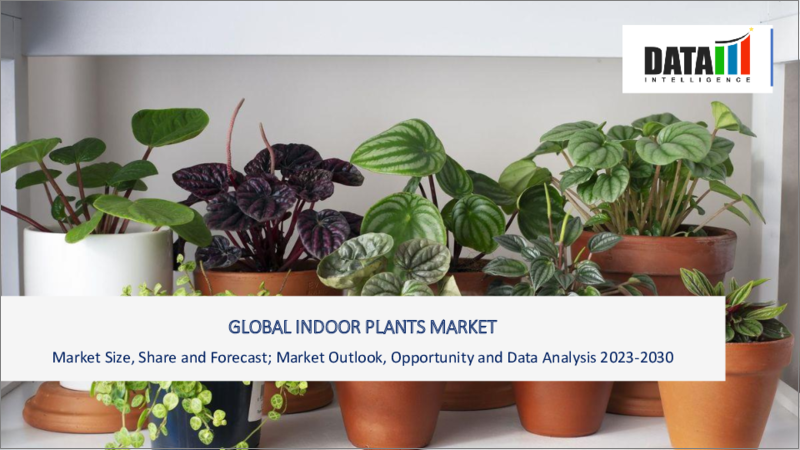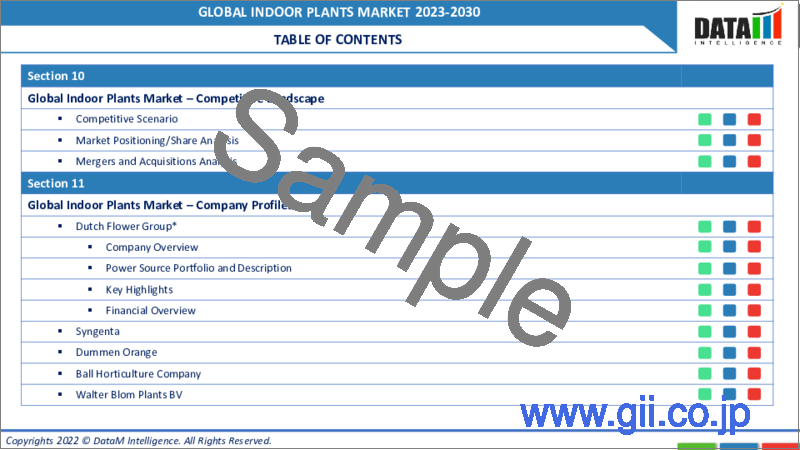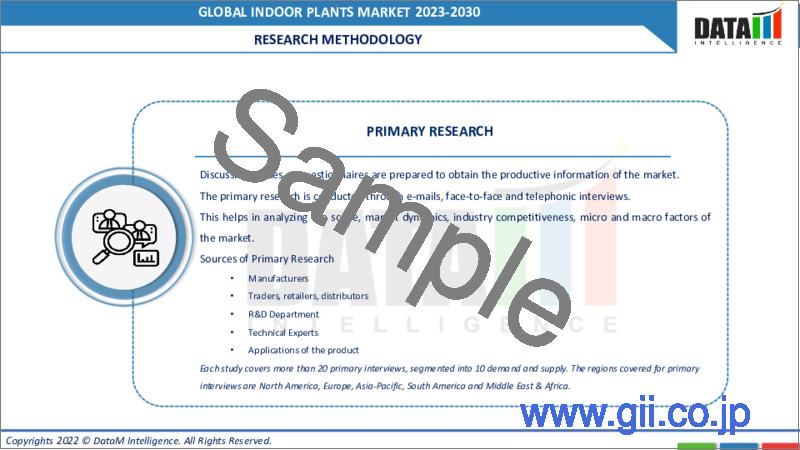|
|
市場調査レポート
商品コード
1146462
室内観葉植物の世界市場-2022-2029Global Indoor Plants Market - 2022-2029 |
||||||
|
● お客様のご希望に応じて、既存データの加工や未掲載情報(例:国別セグメント)の追加などの対応が可能です。 詳細はお問い合わせください。 |
|||||||
| 室内観葉植物の世界市場-2022-2029 |
|
出版日: 2022年10月31日
発行: DataM Intelligence
ページ情報: 英文 170 Pages
納期: 約2営業日
|
- 全表示
- 概要
- 目次
市場力学
インテリアとしての室内観葉植物の人気の高まりが市場成長を牽引
白、ピンク、紫など様々な色を持つ室内装飾用植物の人気が高まっていることが、市場の成長を後押ししています。浴室の装飾には、暗い場所でも育つ室内植物が使用されています。室内観葉植物は、葉の茂った大きなヤシの木から、形の良い小さなサボテンまで、形や色、質感もさまざまで、インテリアデザイナーがアートの生きた形として、多彩な装飾のアイデアを提供し、花をつける品種も忘れられていないです。さらに、ポップで鮮やかな色彩の植物や、彫刻的で有機的なフォルムの植物は、現代のパーティションシェルフの強い建築的なラインと見事に調和しています。また、観葉植物の根や土が空気中の揮発性有機化合物(VOC)を減少させ、密閉された宇宙船の空気の質を改善するなど、室内植物には多くの健康効果もあります。
地理的浸透
予測期間中、北米が主要な地域となります。
北米は、健康的なライフスタイルや食品に関する人々の意識の高まりから、支配的な地域になると予測されており、さらに米国やカナダなどの国々で室内植物市場の成長に積極的に貢献すると期待されています。Ipsos, retail Performanceによると、植物ベースに転向したアメリカ人の数は970万人に達し、15年間で約29万人から増加しています。米国では、アリゾナ、カリフォルニア、フロリダ、ニューメキシコ、ノースカロライナなど、気候の良い西部および南部の州で商業栽培されています。バジルの生産統計は個別には把握されていないが、「ハーブ」という大きなカテゴリーに含まれています。米国へのバジルの輸出は、メキシコの方が多くなっています。うつ病は、世界的に最も深刻な公衆衛生問題の一つであり、地球上のすべての国に影響を及ぼしています。成人期のうつ病は、心血管疾患、いくつかの一般的ながん、糖尿病、変形性関節症など、健康状態の悪化や早期死亡の主な危険因子とされています。カナダやメキシコなどの国々では、子供と大人の肥満と過体重の割合が増え続けています。そのため、特定の健康上の利点が含まれているとして、室内植物の消費量が増加しています。
競合情勢
市場参入企業や現地メーカーが複数存在するため、市場は細分化されています。いくつかの主要なキープレイヤーは、シンジェンタ、Beekenkampグループ、Dummenグループ、Hoflandフローイングプランツ、SAKATA、オランダの花グループ、Marginpar BV、ダブルH保育園株式会社、セレクタクラム、KPオランダ、他の間でされています。主要なキープレイヤーの中には、事業拡大のために投資した企業もあります。2021年、Brightfarmsはノースカロライナ州ヘンダーソンビルに最新の室内農場を開設し、生産基盤の拡大に注力するとともに、新たな室内農業システムの設置に積極的に取り組んでいます。Bright Farmsは2019年にマサチューセッツ、ニューヨーク、ノースカロライナに3つの新しい持続可能な温室農場を開設し、建設部門を拡大しました。2021年にBoweryは、資金を米国全域のスマート室内農場のネットワークを拡大するために使用すると述べたニューヨーク市に拠点を置く垂直農業スタートアップは、3億米ドルのシリーズCラウンドの資金調達を発表しました。
COVID-19のインパクト世界の屋内植物市場にポジティブなインパクト
COVID-19のパンデミック時には、ほとんどの人が自宅で仕事をし、政府の規制により輸出入が途絶えました。室内植物は、吸収、希釈、沈殿、ろ過といったさまざまな方法で空気を浄化することができるため、天然のエアフィルターと考えられており、植物が汚染物質から環境を浄化するさまざまな技術によってできるファイトレメディエーションと呼ばれるプロセスで環境の効率的な洗浄システムとして使用されています。COVID-19が大流行したとき、人々は家に閉じこもりがちで、そのため室内園芸が盛んになりました。また、パンデミック時に室内用植物の売り上げが伸びた理由として、次のようなことが挙げられます。品薄になる前に買いだめしておこうという消費者心理から、スーパーに行く回数が減ったことや、室内用植物が生ものより安全だという消費者心理が働いたこと。また、家庭料理の需要も増加しました。消費者は屋内植物のオンラインショッピングに目を向けた。
世界の屋内植物市場レポートでは、約61の市場データ表、57の図、170ページの構成で提供しています。
目次
第1章 調査手法と範囲
- 調査手法
- 市場の範囲
第2章 主な動向と発展
第3章 エグゼクティブサマリー
- タイプ別市場内訳
- アプリケーション別市場内訳
- 地域別市場内訳
第4章 市場の力学
- 市場影響要因
- 促進要因
- 抑制要因
- ビジネスチャンス
- 影響分析
第5章 産業分析
- ポーターのファイブフォース分析
- バリューチェーン分析
- 特許分析
- 規制分析
第6章 COVID-19の分析
- COVID-19の市場分析
- COVID-19以前の市場シナリオ
- COVID-19の現在の市場シナリオ
- COVID-19の後、または将来のシナリオ
- COVID-19の中での価格ダイナミクス
- 需要-供給スペクトラム
- パンデミック時の市場に関連する政府の取り組み
- メーカーの戦略的取り組み
第7章 タイプ別
- 多肉植物
- 草本植物
- 木質系植物
- 水耕栽培植物
第8章 用途別
- 有害ガスの吸着
- ホームデコ
第9章 地域別
- 北米
- 米国
- カナダ
- メキシコ
- 南米
- ブラジル
- アルゼンチン
- その他の南米地域
- 欧州
- ドイツ
- 英国
- フランス
- スペイン
- イタリア
- その他の欧州地域
- アジア太平洋地域
- 中国
- インド
- 日本
- オーストラリア
- その他アジア太平洋地域
- 中東・アフリカ地域
第10章 競合情勢
- 競合シナリオ
- 競合の戦略分析
- 市況/シェア分析
- M&A(合併・買収)分析
第11章 企業プロファイル
- Dutch Flower Group
- 企業概要
- 製品ポートフォリオと説明
- 主なハイライト
- 財務概要
- Syngenta
- Dummen Orange
- Ball Horticulture Company
- Walter Blom Plants BV
- SAKATA
- Beekenkamp Group
- Double H Nurseries
- Hofland Flowering Plants
- KP Holland
第12章 DataM
Market Overview
Indoor plants are an ornamental plant that is grown indoors and also known as pot plant and potted plant. House plants or indoor plants are obtained either by collecting wild specimens of plants, or by growing them in greenhouses or nurseries. The wild collection of plants for the houseplant trade is a major threat to many species, especially plants with limited native ranges. Indoor plants are a great option for those who have little yard space for an outdoor garden or for those who live in climates with severely cold winters and along with this indoor plant are popular because they are relatively easy to take care of, provide health benefits and can be used in a variety of indoor decor themes. The growing popularity of the indoor plants as a decorative element is expected to drive market growth.
The global indoor plants market was growing at a CAGR of 4.94% during the forecast period (2022-2029).
Market Dynamics: Increasing popularity of indoor plants as interior decoration drives the market growth
The growing popularity of the indoor plants as a decorative element with various colors including white, pink, and violet has driven the growth of the market. For the purpose of bathroom decoration indoor plants are used that tolerates low light and thrive in tricky areas. Indoor plants make versatile decorating ideas and are used by interior designers as living forms of art which are available in host of shapes, forms, colors and textures, from large leafy palms to small shapely cacti, not forgetting flowering varieties. Moreover, indoor plants pops of vibrant color, plants with sculptural, organic forms are a fabulous antidote to the strong architectural lines of contemporary partition shelves. The indoor plants have many health benefits as well such roots and soil of houseplants reduced airborne volatile organic compounds (VOCs) significantly improving the air quality in a sealed spacecraft.
Market Segmentation: Hydrophonics plants segment accounted for the highest share in global indoor plants market
The hydroponics plants segment accounted for a dominant share in the market over the forecast period and it includes lettuce, spinach, strawberries, bell peppers, herbs. Basils are one of the best hydroponics plants as it has lots of health benefits. Basils are rich in vitamin A, vitamin K, vitamin C, magnesium, iron, potassium, and calcium due to which they are used in a variety of culinary preparations. In addition to the flavor, the culinary herb is said to preserve and enhance the properties of the food. Basil is extremely rich in many vitamins, nutrients and minerals that are necessary for the human body to function at its best due to which it treats fever, common cold, stress, purifying the blood, reducing blood glucose, risk of heart attacks and cholesterol level. Sweet basil is an excellent source of antioxidants such as phenolic compounds and polyphenols due to which it is used in tea leaves as it can act as an antioxidant and help the body get rid of free radicals. In addition, basils are used for stomach spasms, loss of appetite, intestinal gas, kidney conditions, fluid retention, head colds, warts, and worm infections and having endless miraculous and medicinal values, organic basil is one of the best medicinal herbs to have been discovered. Also known as the holy basil, it functions as an adaptogen, enhancing the body's natural response to physical and emotional stress.
Geographical Penetration: North America is dominating region during the forecast period
North America is projected to be the dominating region due to the rising awareness among people regarding a healthy lifestyle and food products is further expected to contribute positively to the indoor plants market growth in the countries such as the United States and Canada. According to Ipsos, retail Performance, the number of Americans turning plant-based has reached 9.7 million people, growing from around 290,000 over a period of 15 years. In the United States, basil is grown commercially in western and southern states where the climate is favorable including Arizona, California, Florida, New Mexico, and North Carolina. Production statistics for basil are not tracked individually, but they are included in the larger 'herb' category. Mexico is a larger exporter of basil to the United States. Depression is one of the most serious global public health issues, affecting every country on the planet. Depression in adulthood is a major risk factor for poor health and premature death, including cardiovascular disease, several common cancers, diabetes, and osteoarthritis. Obesity and overweight rates in children and adults continue to rise in countries such as Canada, Mexico. Owing to which the consumption of indoor plants has increased as it contains certain health benefits.
Competitive Landscape:
There are several established participants in the industry and local manufacturers; hence, the market is fragmented. Some major key players are Syngenta, Beekenkamp Group, Dummen Group, Hofland Flowing Plants, SAKATA, Dutch Flower Group, Marginpar BV, Double H Nurseries Ltd., Selecta Klemm, KP Holland, among others. Some of the major key players invested in expanding their business. In 2021, Brightfarms opened its latest indoor farm in Hendersonville, North Carolina and is focused on expanding their production base and actively involved in the installation of new indoor farming systems. Bright Farms expanded its construction division in 2019 by opening three new sustainable greenhouse farms in Massachusetts, New York, and North Carolina.In 2021, Bowery stated that the funds would be used to expand its network of smart indoor farms across the United States a vertical farming startup based in New York City, announced a USD 300 million Series C round of funding.
COVID-19 Impact: Positive impact on the global indoor plants market
During the COVID-19 pandemic, most people worked from home, and due to government restrictions, export and imports were disrupted. Indoor plants are considered to be natural air filters as they can purify air through different methods: absorption, dilution, precipitation, and filtration and used as an efficient cleaning system for the environment in a process known as Phytoremediation, which can be done through various techniques in which plants clear the environment from pollutants. People used to stay in home during the COVID-19 pandemic owing to the lockdowns due to which indoor gardening also increased. Some of the other reasons which led to increase in sales of indoor plants during the pandemic. Consumer desire to stock up in case of shortages enabled consumers to limit the number of trips to the grocery store and consumers' belief that indoor plants are safer than fresh items. Also, the demand for home-prepared meals increased. Consumers turned to online shopping for indoor plants.
The global indoor plants market report would provide an access to approximately 61 market data tables, 57 figures and 170 pages.
Table of Contents
1. Scope and Methodology
- 1.1. Research Methodology
- 1.2. Scope of the Market
2. Key Trends and Developments
3. Executive Summary
- 3.1. Market Snippet by Type
- 3.2. Market Snippet by Application
- 3.3. Market Snippet by Region
4. Market Dynamics
- 4.1. Market impacting factors
- 4.1.1. Drivers
- 4.1.2. Restraints
- 4.1.3. Opportunities
- 4.2. Impact analysis
5. Industry Analysis
- 5.1. Porter's five forces analysis
- 5.2. Value chain analysis
- 5.3. Patent Analysis
- 5.4. Regulatory Analysis
6. COVID-19 Analysis
- 6.1. Analysis of Covid-19 on the Market
- 6.1.1. Before COVID-19 Market Scenario
- 6.1.2. Present COVID-19 Market Scenario
- 6.1.3. After COVID-19 or Future Scenario
- 6.2. Pricing Dynamics Amid Covid-19
- 6.3. Demand-Supply Spectrum
- 6.4. Government Initiatives Related to the Market During Pandemic
- 6.5. Manufacturers Strategic Initiatives
7. By Type
- 7.1. Introduction
- 7.1.1. Market size analysis, and y-o-y growth analysis (%), By TypeSegment
- 7.1.2. Market attractiveness index, By Type Segment
- 7.2. Succulent Plants*
- 7.2.1. Introduction
- 7.2.2. Market Size Analysis, US$ Million, 2020-2029 And Y-O-Y Growth Analysis (%), 2021-2029
- 7.3. Berbaceous Plants
- 7.4. Woody Plants
- 7.5. Hydroponics Plants
8. By Application
- 8.1. Introduction
- 8.1.1. Market size analysis, and y-o-y growth analysis (%), By Application Segment
- 8.1.2. Market attractiveness index, By Application Segment
- 8.2. Absorb Harmful Gases*
- 8.2.1. Introduction
- 8.2.2. Market Size Analysis, US$ Million, 2020-2029 And Y-O-Y Growth Analysis (%), 2021-2029
- 8.3. Home Decoration
9. By Region
- 9.1. Introduction
- 9.1.1. Market Size Analysis, And Y-O-Y Growth Analysis (%), By Region
- 9.1.2. Market Attractiveness Index, By Region
- 9.2. North America
- 9.2.1. Introduction
- 9.2.2. Key region-specific dynamics
- 9.2.3. Market Size Analysis, And Y-O-Y Growth Analysis (%), By Type
- 9.2.4. Market Size Analysis, And Y-O-Y Growth Analysis (%), By Application
- 9.2.5. Market Size Analysis, And Y-O-Y Growth Analysis (%), By Country
- 9.2.5.1. U.S.
- 9.2.5.2. Canada
- 9.2.5.3. Mexico
- 9.3. South America
- 9.3.1. Introduction
- 9.3.2. Key Region-Specific Dynamics
- 9.3.3. Market Size Analysis, And Y-O-Y Growth Analysis (%), By Type
- 9.3.4. Market Size Analysis, And Y-O-Y Growth Analysis (%), By Application
- 9.3.5. Market Size Analysis, And Y-O-Y Growth Analysis (%), By Country
- 9.3.5.1. Brazil
- 9.3.5.2. Argentina
- 9.3.5.3. Rest of South America
- 9.4. Europe
- 9.4.1. Introduction
- 9.4.2. Key Region-Specific Dynamics
- 9.4.3. Market Size Analysis, And Y-O-Y Growth Analysis (%), By Type
- 9.4.4. Market Size Analysis, And Y-O-Y Growth Analysis (%), By Application
- 9.4.5. Market Size Analysis, And Y-O-Y Growth Analysis (%), By Country
- 9.4.5.1. Germany
- 9.4.5.2. U.K.
- 9.4.5.3. France
- 9.4.5.4. Spain
- 9.4.5.5. Italy
- 9.4.5.6. Rest of Europe
- 9.5. Asia Pacific
- 9.5.1. Introduction
- 9.5.2. Key Region-Specific Dynamics
- 9.5.3. Market Size Analysis, And Y-O-Y Growth Analysis (%), By Type
- 9.5.4. Market Size Analysis, And Y-O-Y Growth Analysis (%), By Application
- 9.5.5. Market Size Analysis, And Y-O-Y Growth Analysis (%), By Country
- 9.5.5.1. China
- 9.5.5.2. India
- 9.5.5.3. Japan
- 9.5.5.4. Australia
- 9.5.5.5. Rest of Asia Pacific
- 9.6. Middle East and Africa
- 9.6.1. Introduction
- 9.6.2. Key Region-Specific Dynamics
- 9.6.3. Market Size Analysis, And Y-O-Y Growth Analysis (%), By Type
- 9.6.4. Market Size Analysis, And Y-O-Y Growth Analysis (%), By Application
- 9.6.5. Market Size Analysis, And Y-O-Y Growth Analysis (%), By Country
10. Competitive Landscape
- 10.1. Competitive scenario
- 10.2. Competitor strategy analysis
- 10.3. Market positioning/share analysis
- 10.4. Mergers and acquisitions analysis
11. Company Profiles
- 11.1. Dutch Flower Group*
- 11.1.1. Company Overview
- 11.1.2. Product Portfolio and Description
- 11.1.3. Key Highlights
- 11.1.4. Financial Overview
- 11.2. Syngenta
- 11.3. Dummen Orange
- 11.4. Ball Horticulture Company
- 11.5. Walter Blom Plants BV
- 11.6. SAKATA
- 11.7. Beekenkamp Group
- 11.8. Double H Nurseries
- 11.9. Hofland Flowering Plants
- 11.10. KP Holland
- List not Exhaustive*
12. DataM
- 12.1. Appendix
- 12.2. About us and services
- 12.3. Contact us




